seats CHEVROLET KODIAK 2009 Owners Manual
[x] Cancel search | Manufacturer: CHEVROLET, Model Year: 2009, Model line: KODIAK, Model: CHEVROLET KODIAK 2009Pages: 376, PDF Size: 5.39 MB
Page 1 of 376

Seats and Restraint System............................. 1-1
Front Seats
............................................... 1-2
Rear Seats
..............................................1-10
Safety Belts
.............................................1-11
Child Restraints
.......................................1-28
Airbag System
.........................................1-48
Restraint System Check
............................1-59
Features and Controls..................................... 2-1
Keys
........................................................ 2-2
Doors and Locks
....................................... 2-6
Windows
.................................................. 2-8
Starting and Operating Your Vehicle
...........2-10
Mirrors
....................................................2-51
Storage Areas
.........................................2-53
Instrument Panel............................................. 3-1
Instrument Panel Overview
.......................... 3-4
Climate Controls
......................................3-20
Warning Lights, Gages, and Indicators
........3-23
Audio System(s)
.......................................3-48
Driving Your Vehicle....................................... 4-1
Your Driving, the Road, and the Vehicle
....... 4-2
Towing
...................................................4-23Service and Appearance Care.......................... 5-1
Service
..................................................... 5-3
Fuel
......................................................... 5-6
Checking Things Under the Hood
...............5-22
Rear Axle
...............................................5-67
Four-Wheel Drive
.....................................5-68
Front Axle
...............................................5-69
Noise Control System
...............................5-70
Bulb Replacement
....................................5-71
Windshield Wiper Blade Replacement
.........5-71
Other Service Items
..................................5-72
Tires
......................................................5-76
Appearance Care
.....................................5-87
Vehicle Identification
.................................5-94
Electrical System
......................................5-95
Capacities and Specifications
...................5-102
Normal Maintenance Replacement Parts
....5-108
Maintenance Schedule..................................... 6-1
Maintenance Schedule
................................ 6-2
Customer Assistance Information.................... 7-1
Customer Assistance and Information
........... 7-2
Reporting Safety Defects
............................ 7-9
Vehicle Data Recording and Privacy
...........7-11
Index................................................................ 1
2009 Chevrolet Kodiak Owner ManualM
Page 5 of 376
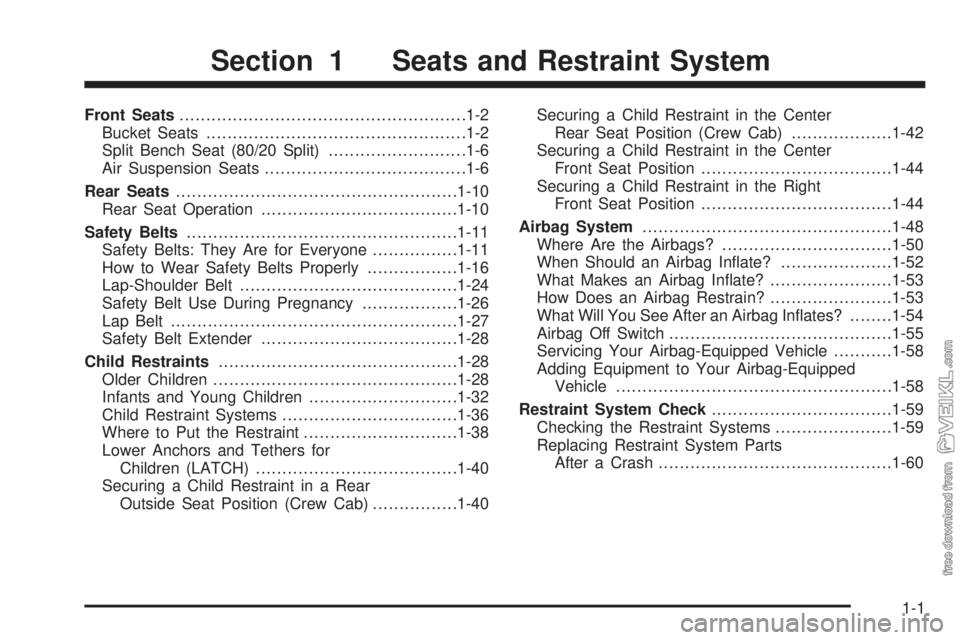
Front Seats......................................................1-2
Bucket Seats.................................................1-2
Split Bench Seat (80/20 Split)..........................1-6
Air Suspension Seats......................................1-6
Rear Seats.....................................................1-10
Rear Seat Operation.....................................1-10
Safety Belts...................................................1-11
Safety Belts: They Are for Everyone................1-11
How to Wear Safety Belts Properly.................1-16
Lap-Shoulder Belt.........................................1-24
Safety Belt Use During Pregnancy..................1-26
Lap Belt......................................................1-27
Safety Belt Extender.....................................1-28
Child Restraints.............................................1-28
Older Children..............................................1-28
Infants and Young Children............................1-32
Child Restraint Systems.................................1-36
Where to Put the Restraint.............................1-38
Lower Anchors and Tethers for
Children (LATCH)......................................1-40
Securing a Child Restraint in a Rear
Outside Seat Position (Crew Cab)................1-40Securing a Child Restraint in the Center
Rear Seat Position (Crew Cab)...................1-42
Securing a Child Restraint in the Center
Front Seat Position....................................1-44
Securing a Child Restraint in the Right
Front Seat Position....................................1-44
Airbag System...............................................1-48
Where Are the Airbags?................................1-50
When Should an Airbag Inflate?.....................1-52
What Makes an Airbag Inflate?.......................1-53
How Does an Airbag Restrain?.......................1-53
What Will You See After an Airbag Inflates?........1-54
Airbag Off Switch..........................................1-55
Servicing Your Airbag-Equipped Vehicle...........1-58
Adding Equipment to Your Airbag-Equipped
Vehicle...................................................
.1-58
Restraint System Check..................................1-59
Checking the Restraint Systems......................1-59
Replacing Restraint System Parts
After a Crash............................................1-60
Section 1 Seats and Restraint System
1-1
Page 6 of 376
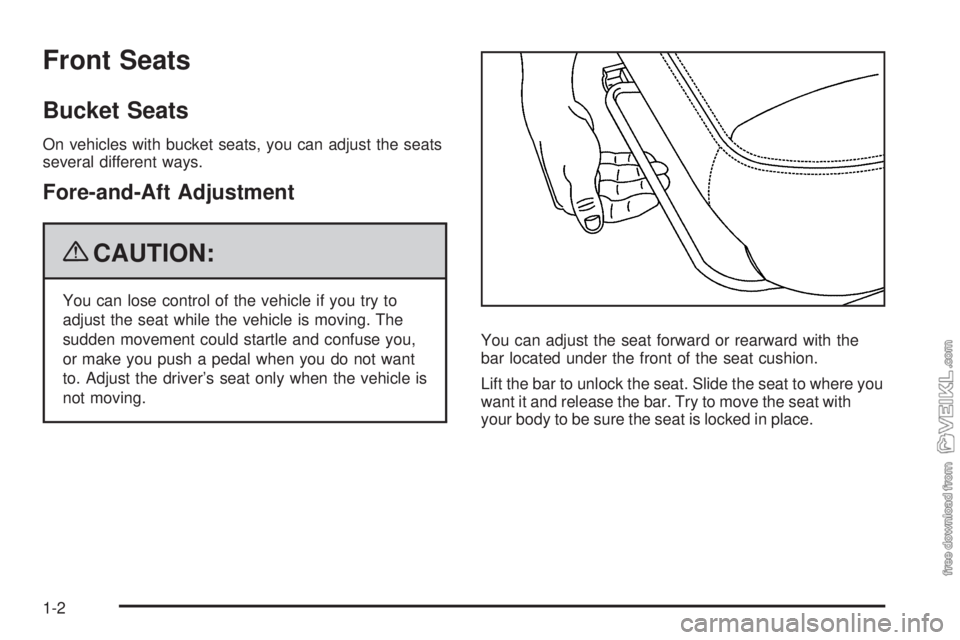
Front Seats
Bucket Seats
On vehicles with bucket seats, you can adjust the seats
several different ways.
Fore-and-Aft Adjustment
{CAUTION:
You can lose control of the vehicle if you try to
adjust the seat while the vehicle is moving. The
sudden movement could startle and confuse you,
or make you push a pedal when you do not want
to. Adjust the driver’s seat only when the vehicle is
not moving.You can adjust the seat forward or rearward with the
bar located under the front of the seat cushion.
Lift the bar to unlock the seat. Slide the seat to where you
want it and release the bar. Try to move the seat with
your body to be sure the seat is locked in place.
1-2
Page 7 of 376

Lumbar Adjustment
Your seats may have this feature.
The lumbar adjustment
knob is located on the
seatback, on the inboard
side of the driver’s seat and
on the outboard side of the
passenger’s seat.For more support to your lower back, turn the lumbar
adjustment knob clockwise. To decrease the amount of
lumbar support, turn the knob counterclockwise.
1-3
Page 10 of 376

Split Bench Seat (80/20 Split)
If your vehicle has a split bench seat, the passenger
seat is not adjustable.
There is a storage area underneath the seat cushion.
SeeStorage Areas on page 2-53.
Air Suspension Seats
Your vehicle may have a low-back or high-back air
suspension seat. There are several ways to adjust
the seat.
Fore-and-Aft Adjustment
If your vehicle has this lever
it is located underneath the
front of the driver’s seat.
To slide the seat forward or rearward, move the lever
toward the outboard side of the seat. The seat will lock in
at 1/2 inch (1.5 cm) increments. Try to move the seat with
your body to be sure the seat is locked in place.
1-6
Page 13 of 376
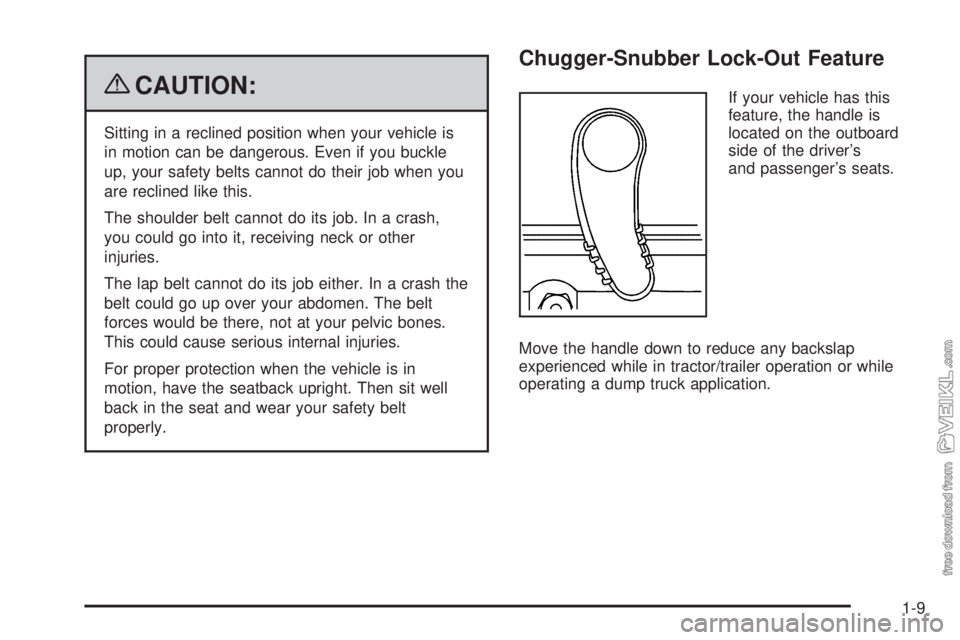
{CAUTION:
Sitting in a reclined position when your vehicle is
in motion can be dangerous. Even if you buckle
up, your safety belts cannot do their job when you
are reclined like this.
The shoulder belt cannot do its job. In a crash,
you could go into it, receiving neck or other
injuries.
The lap belt cannot do its job either. In a crash the
belt could go up over your abdomen. The belt
forces would be there, not at your pelvic bones.
This could cause serious internal injuries.
For proper protection when the vehicle is in
motion, have the seatback upright. Then sit well
back in the seat and wear your safety belt
properly.
Chugger-Snubber Lock-Out Feature
If your vehicle has this
feature, the handle is
located on the outboard
side of the driver’s
and passenger’s seats.
Move the handle down to reduce any backslap
experienced while in tractor/trailer operation or while
operating a dump truck application.
1-9
Page 14 of 376
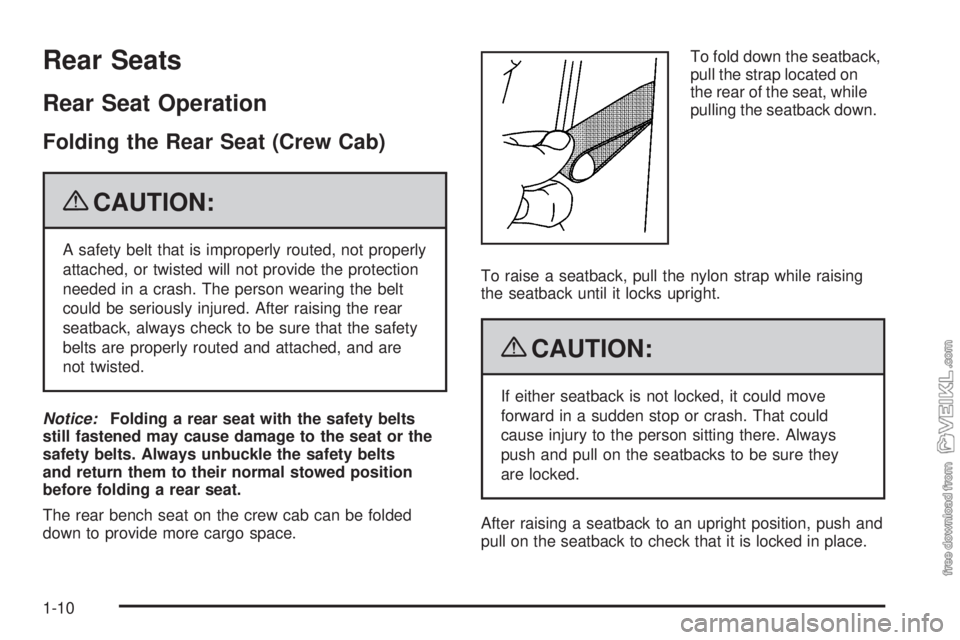
Rear Seats
Rear Seat Operation
Folding the Rear Seat (Crew Cab)
{CAUTION:
A safety belt that is improperly routed, not properly
attached, or twisted will not provide the protection
needed in a crash. The person wearing the belt
could be seriously injured. After raising the rear
seatback, always check to be sure that the safety
belts are properly routed and attached, and are
not twisted.
Notice:Folding a rear seat with the safety belts
still fastened may cause damage to the seat or the
safety belts. Always unbuckle the safety belts
and return them to their normal stowed position
before folding a rear seat.
The rear bench seat on the crew cab can be folded
down to provide more cargo space.To fold down the seatback,
pull the strap located on
the rear of the seat, while
pulling the seatback down.
To raise a seatback, pull the nylon strap while raising
the seatback until it locks upright.
{CAUTION:
If either seatback is not locked, it could move
forward in a sudden stop or crash. That could
cause injury to the person sitting there. Always
push and pull on the seatbacks to be sure they
are locked.
After raising a seatback to an upright position, push and
pull on the seatback to check that it is locked in place.
1-10
Page 15 of 376
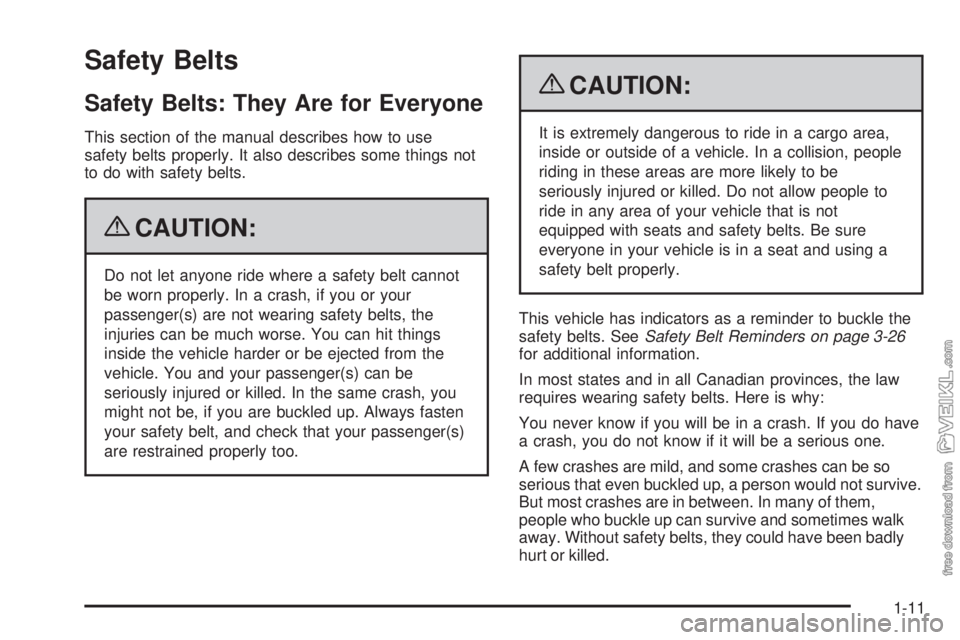
Safety Belts
Safety Belts: They Are for Everyone
This section of the manual describes how to use
safety belts properly. It also describes some things not
to do with safety belts.
{CAUTION:
Do not let anyone ride where a safety belt cannot
be worn properly. In a crash, if you or your
passenger(s) are not wearing safety belts, the
injuries can be much worse. You can hit things
inside the vehicle harder or be ejected from the
vehicle. You and your passenger(s) can be
seriously injured or killed. In the same crash, you
might not be, if you are buckled up. Always fasten
your safety belt, and check that your passenger(s)
are restrained properly too.
{CAUTION:
It is extremely dangerous to ride in a cargo area,
inside or outside of a vehicle. In a collision, people
riding in these areas are more likely to be
seriously injured or killed. Do not allow people to
ride in any area of your vehicle that is not
equipped with seats and safety belts. Be sure
everyone in your vehicle is in a seat and using a
safety belt properly.
This vehicle has indicators as a reminder to buckle the
safety belts. SeeSafety Belt Reminders on page 3-26
for additional information.
In most states and in all Canadian provinces, the law
requires wearing safety belts. Here is why:
You never know if you will be in a crash. If you do have
a crash, you do not know if it will be a serious one.
A few crashes are mild, and some crashes can be so
serious that even buckled up, a person would not survive.
But most crashes are in between. In many of them,
people who buckle up can survive and sometimes walk
away. Without safety belts, they could have been badly
hurt or killed.
1-11
Page 28 of 376
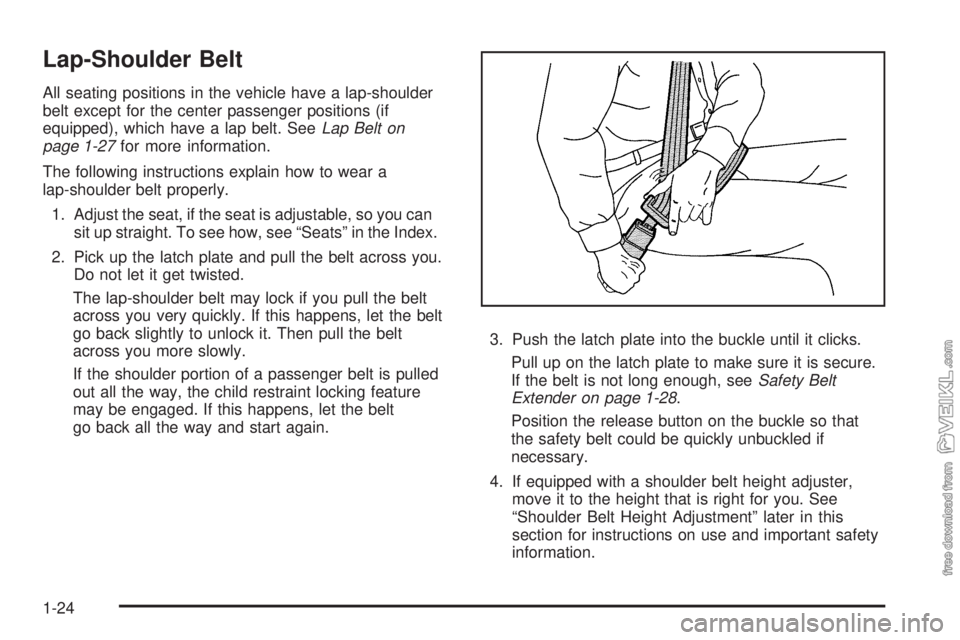
Lap-Shoulder Belt
All seating positions in the vehicle have a lap-shoulder
belt except for the center passenger positions (if
equipped), which have a lap belt. SeeLap Belt on
page 1-27for more information.
The following instructions explain how to wear a
lap-shoulder belt properly.
1. Adjust the seat, if the seat is adjustable, so you can
sit up straight. To see how, see “Seats” in the Index.
2. Pick up the latch plate and pull the belt across you.
Do not let it get twisted.
The lap-shoulder belt may lock if you pull the belt
across you very quickly. If this happens, let the belt
go back slightly to unlock it. Then pull the belt
across you more slowly.
If the shoulder portion of a passenger belt is pulled
out all the way, the child restraint locking feature
may be engaged. If this happens, let the belt
go back all the way and start again.3. Push the latch plate into the buckle until it clicks.
Pull up on the latch plate to make sure it is secure.
If the belt is not long enough, seeSafety Belt
Extender on page 1-28.
Position the release button on the buckle so that
the safety belt could be quickly unbuckled if
necessary.
4. If equipped with a shoulder belt height adjuster,
move it to the height that is right for you. See
“Shoulder Belt Height Adjustment” later in this
section for instructions on use and important safety
information.
1-24
Page 32 of 376
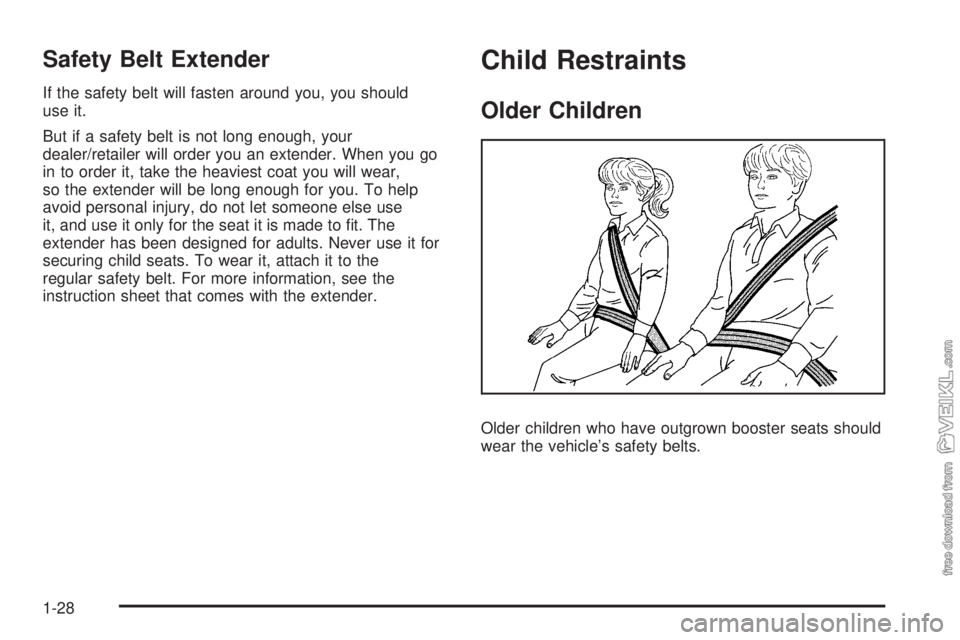
Safety Belt Extender
If the safety belt will fasten around you, you should
use it.
But if a safety belt is not long enough, your
dealer/retailer will order you an extender. When you go
in to order it, take the heaviest coat you will wear,
so the extender will be long enough for you. To help
avoid personal injury, do not let someone else use
it, and use it only for the seat it is made to fit. The
extender has been designed for adults. Never use it for
securing child seats. To wear it, attach it to the
regular safety belt. For more information, see the
instruction sheet that comes with the extender.
Child Restraints
Older Children
Older children who have outgrown booster seats should
wear the vehicle’s safety belts.
1-28